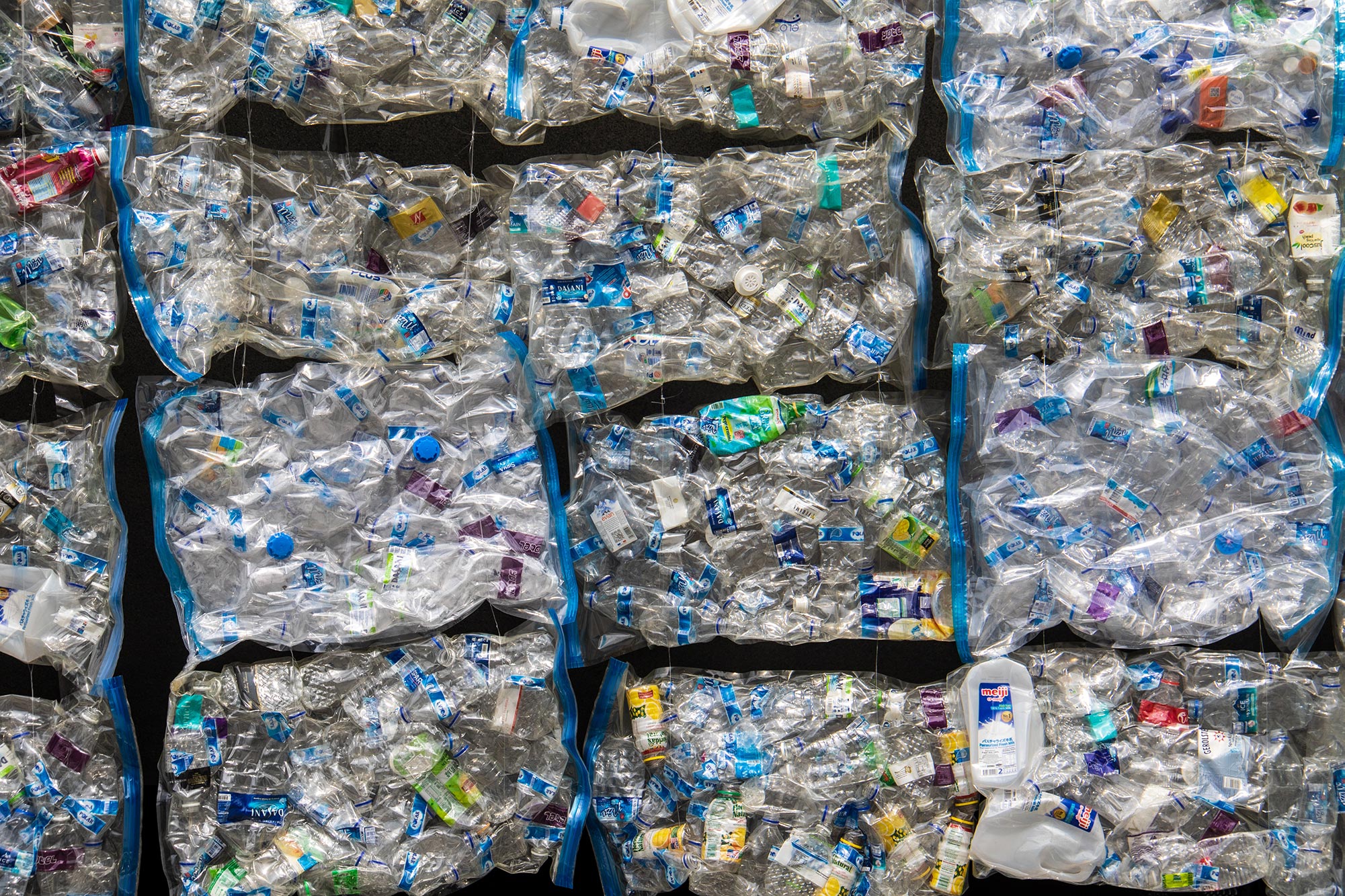
Can plastics recycling be profitable?
Plastics recycling in industrial areas
plastics, plastics recycling, circular economy, resource wisdom, business cooperation, port, waste, value chain, piloting, reuse
It has become apparent that more plastics need to be recycled. The purpose of this concept is to launch plastic recycling activities in industrial areas and to create cooperation between companies to achieve climate goals. An experiment was carried out to illustrate the functionality of recycling, to obtain information about the volumes of plastics and to collect feedback from companies in Vuosaari Harbour.
- 6443 kg/year: the theoretical amount of plastic waste generated in Vuosaari Harbour.
- 80% of the collected plastics could be reused instead of being used to produce energy according to the pilot project.
- Emissions: carbon dioxide emissions are significantly lower in recycling-oriented solutions than in the current solution in which plastic waste is mainly burnt.
This solution is suitable for
- cities that want to encourage companies to do their bit for climate change;
- companies that want to start recycling their waste or improve their existing procedures;
- companies that are looking for new business opportunities in the recycling sector.
BASIC FACTS
- Location: Vuosaari Harbour, Helsinki
- Life cycle: active phase.
- Organisers: Satu Pasanen/VTT Technical Research Centre of Finland, Juha Hakala/VTT Technical Research Centre of Finland, Saara Pellikka/City of Helsinki.
- Time span: 3 months – 1 year.
- A ‘plastic pilot’, a joint experiment to collect plastic waste from companies, was carried out during the concept development phase. Packaging plastics and plastics from logistics operations were collected from companies in Vuosaari Harbour. The pilot project was carried out in cooperation with the City of Helsinki and the Port of Helsinki between 16 November and 31 December 2020.
- The recycling solutions were compared to the current ones from the perspective of the economy and carbon emissions.
- The concept encourages the reuse of plastics.
The first plastic recycling concept in Vuosaari Harbour
National and international targets, such as the plastics roadmap for Finland and the EU plastics strategy, accelerate the recycling of plastics. The concept was inspired by the enthusiasm of companies in Vuosaari Harbour for recycling – it started at the grassroots level. The purpose of the concept is primarily to start collecting plastics in the industrial area and, secondarily, to promote cooperation between competing companies to achieve the climate goals.
During the conceptualisation phase, a pilot project was carried out in collaboration with public-sector operators, companies and a research institute. Practical experiments such as this produce scientifically valid and pragmatic data, encourage companies to try new work methods and increase dialogue between cities and businesses.
Piloting provides facts for conceptualisation
A ‘plastic pilot’, a joint experiment to collect plastic waste from companies, was carried out during the concept development phase. Packaging plastics and plastics from logistics operations were collected from companies in Vuosaari Harbour. The pilot project was carried out in cooperation with the City of Helsinki and the Port of Helsinki between 16 November and 31 December 2020. Seven logistics companies took part. Plastic material was collected in a waste compactor equipped with a smart scale, which was on loan from Europress Group Oy for the duration of the test.
A total of 812 kg of various types of plastics was collected, mainly polyethylene (LDPE) and polypropylene (PP), which were taken to be reused. The plastic materials were sufficiently clean for the purposes of the collection experiment. Participants filled in a questionnaire afterwards that collected feedback and user experiences for concept development. Most participants found it easy to take part in the plastic pilot and joint collection efforts. Companies thought that collaboration was viable, especially with regard to waste management and other environmental services.
Comparative information with economic and environmental perspectives
The economic perspective was illustrated and assessed in the context of Vuosaari Harbour’s location and the pilot carried out there. Different solutions were created for this industrial area in terms of waste management and recycling, and in addition to the current situation, two alternative solutions are presented, A and B. In the current situation (REF), plastic waste is not recycled but is sent to be burnt at a waste-to-energy facility. Solution A does not involve sorting at the place of origin but all plastic waste is put together and taken to a recycling company. In solution B, plastic waste is sorted at the place of origin, i.e. only LDPE and PP plastic waste is collected.
The results show that the current situation (REF) is the cheapest if only 6.5 tonnes of plastic waste is generated per year, but this option becomes the most expensive as the amount of waste increases. Solutions A and B, which encourage people to recycle, are more economical when the volume is 1.5–2 times higher. Carbon emissions in solutions A and B are significantly lower than in the reference situation. An increase in the amount of plastic waste in solutions A and B generates lower level of emissions than the reference situation.
Putting the concept into practice
The concept is based on solution B, in which the LDPE and PP waste collected from the companies in the port is sent to mechanical recycling. There is also already an industrial recycling solution. As it develops, the concept aims to apply solution A, in which a wider variety of plastic waste can be collected and sent either to be reused as recycled material or as material for the petrochemical industry. Introducing solution A will require cooperation with a suitable recycling or sorting company located near the industrial area. In both solutions, the flow of plastic waste from nearby areas is added to the flow from the port as this increases the impact on the local area. The concept is based on the idea that plastic waste generated in the area is returned there in products used in the area (e.g. packaging films or bags) or is used in products such as fuels used by machines in the area.
All respondents said that a joint collection of plastics should remain a permanent part of the port’s operations. The joint collection model is easy to adopt and scale to suit different types of industrial areas. Expanded to cover the whole country, this type of activity in industrial areas would have the potential for substantial emissions reductions.

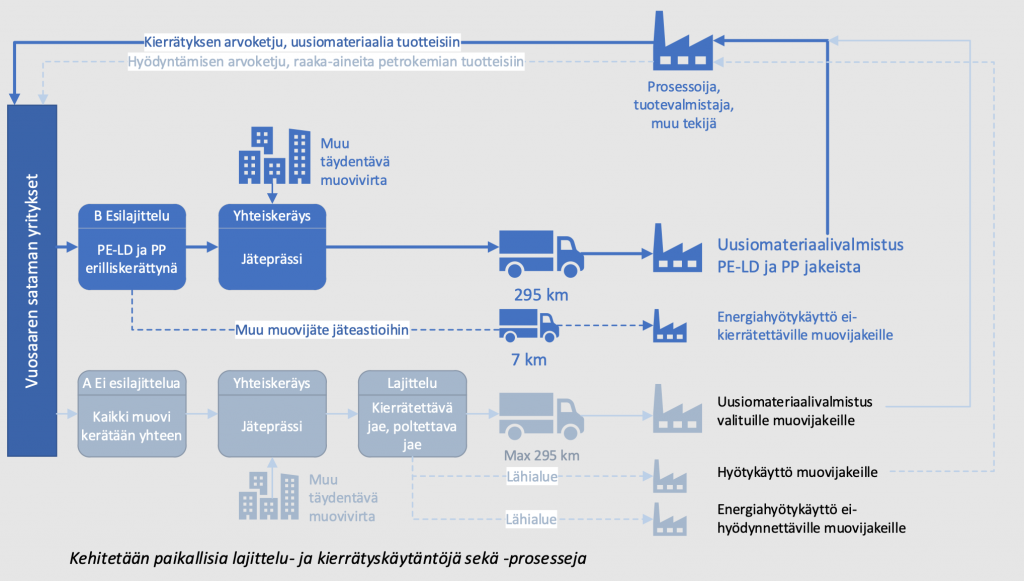
TAKE-HOME MESSAGES
- Companies are enthusiastic about plastic recycling and they want their operations to be more sustainable.
- Piloting provides scientifically valid, practical information on the amount of waste generated in an area and companies’ recycling-related requirements and practices.
- Competing companies can collaborate and gain environmental and economic benefits.
- Cities will be able to persuade companies to adapt the climate goals by launching new pilot projects that focus on emissions reductions and resource wisdom and that benefit companies in the short or long term.
“As the global use of plastics increases, we need recycling to curb this trend. Solutions are created at the local, national and international level. Recycling captures plastic waste for reuse or recovery and offers environmental and economic benefits to businesses.”
– Satu Pasanen, Research Scientist, Circular Economy Developer, VTT Technical Research Centre of Finland
Download
Links
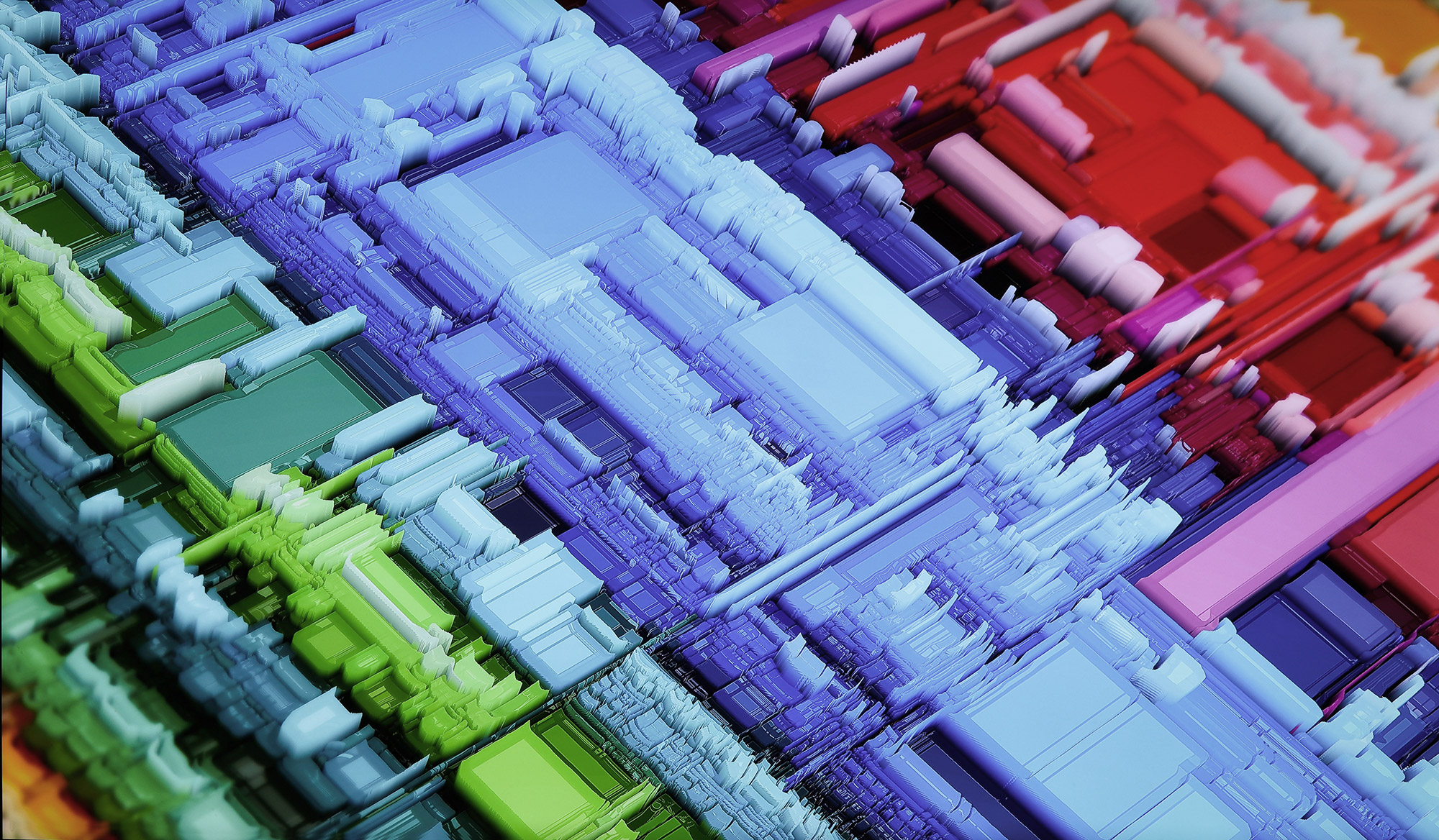
What will the virtual industrial area of the future look like?

A virtual industrial area as a platform for sustainable business
platform, platform economy, cooperation, business model, sharing, information system
A virtual industrial area is a modular service platform built in conjunction with an actual industrial area to improve communications between operators and to create opportunities for companies in the area to work together to promote their businesses, carbon neutrality and resource wisdom.
- Willingness and creativity: for a virtual industrial area to be viable, companies in the area must be willing and have the creativity to build an understanding of what the shared virtual industrial area could look like.
- The role of cities: cities can play key roles in the building of virtual industrial areas, and the concept may well contribute to achieving their carbon neutrality goals.
- Different levels: a virtual industrial area can have a number of levels and operating models that can be developed module by module as required.
This solution is right for you if
- you are interested in developing creative solutions of the future for industrial areas;
- you want to develop shared functionalities, sharing services, resource management, better communications or business operations in your industrial area;
- you want to explore new approaches to business environments.
BASIC FACTS
- This concept has been implemented within the framework of futures research. Practical applications require area- and partner-specific assessment and implementation.
- Some virtual industrial area solutions have already been put into practice. Some themes are studied and assessed as opportunities.
- The concept is implemented by:
- University of Turku, Finland Futures Research Centre (FFRC), Essi Silvonen
- VTT Technical Research Centre of Finland, Satu Pasanen and Maria Antikainen
- Specialists and participants in the solutions forums in the HNRY project
- The concept has been piloted with Mika Härkönen and Taneli Fabritius of VTT Bioruukki
Shareable resources and matching needs to create resource-wise solutions
The resource wisdom of a virtual industrial area is based on sharing resources and achieving the highest possible capacity utilisation rate. This will result in a reduced need for resources, a lower environmental load, streamlined operations and improved profitability. A virtual industrial area is a platform that connects nearby companies by providing them with a variety of services and taking responsibility for fulfilling their shared obligations in a transparent manner. It also gives operators in the area bargaining power when negotiating the price of services.
A virtual industrial area can offer:
- solutions for maintaining, servicing and maintaining facilities;
- services related to sharing and joint use;
- solutions for energy harvesting and energy use at the industrial area level;
- solutions for warehouse and transport logistics;
- solutions for materials and side flow management;
- other services;
- solutions to promote staff wellbeing;
- business opportunities for companies in the area, for companies that provide services to them and for the platform operator;
- a platform for product and service development;
- virtual visitor services;
- better connections and communications in the area;
- data collection and processing, means to measure environmental impacts;
- zoning of a specific area.
What is required for the creation of a virtual industrial area?
A virtual industrial area needs a body that is responsible for its construction, implementation and operations. In addition to reducing the environmental burden, the area must also be economically viable. The platform needs a technical implementation model that makes it possible to add, remove and modify functions as the area develops and requirements change.
It is hardly worth building a virtual business platform on the basis of companies’ current needs, but it is necessary to assess their future needs as well as possible changes in their business. Changes to a company’s role on the platform and advances in operating models must be taken into account in the platform’s architecture to ensure that the platform’s operating principles do not limit but support and enable companies’ development.
Virtual industrial areas offer a great variety of trajectories and opportunities. It is unlikely that there are many areas that would immediately try to cover a broad range of functionalities, but it is more likely that an area will use the platform to address certain key challenges or objectives shared by the companies, and that the range of functionalities will expand over the platform’s life cycle.
Case: VTT Bioruukki’s virtual industrial area – an active research, collaboration and business platform
VTT Bioruukki, located in Espoo, is VTT’s piloting centre for bio-based products and circular economy solutions. It is part of Espoo Cleantech Garden, which will undergo a large-scale extension project in the coming years to bring together operators in the fields of science, education and research. Key players in the development of the area are the City of Espoo, Omnia, the Joint Authority of Education in the Espoo Region, and NCC. The aim is to ensure that the area is built into a diverse environment that creates a framework for comfortable housing as well as for successful business operations. The area is estimated to be completed in the 2030s, housing up to 9,000–12,000 people, while the number of new jobs is expected to be about 2,000.
Various levels of cooperation in the virtual industrial area
Education – VTT works with educational institutions on education and projects. The virtual industrial area can be used to reach and use both operators’ networks, to share equipment and expertise and to form consortiums for joint projects.
Piloting – the virtual industrial area can serve as a practical piloting platform and a channel for sharing practical solutions with platform operators and end customers.
Technology commercialisation – the virtual industrial area can help to find early-stage financing as well as international and domestic talent. Professional commercialisation experts can also operate on the platform. It can form a virtual idea incubator and commercialisation platform and provide both leverage and collaboration from larger companies that operate on the platform.
Visitor services – the virtual industrial area can be used for virtual visits as well as virtual presentations for visitors to the actual premises, AR presentations, better accessibility and access to the most interesting details in the place without disrupting piloting operations or compromising trade secrets.
Other services – catering, accommodation, culture, sports, guidance, translation, other professional services.
Resource sharing platform – VTT has piloted an industrial sharing platform in an in-house project, based on the idea of providing companies with a platform to share and find different equipment, machinery and human resources. When companies need something, the smart system can find it in the local area; in this case, in the virtual industrial area.
Environmental and infrastructure services – there is a wide range of functionalities in the actual industrial area, and, by working together closely, operators can have sufficient purchasing volume to be able to negotiate good deals on centralised services.
Local residents – the industrial area combined with areas for housing and businesses and as part of a public transport hub can serve as a research platform for a wide range of services, technologies and products. People who live nearby may also need to be informed of various events or malfunctions that can have an impact on the surrounding areas.
TAKE-HOME MESSAGES
- The resource wisdom of the virtual industrial area is based on sharing resources and achieving the highest possible capacity utilisation rate, which means that the overall need for resources as well as the environmental load are reduced while efficiency and profitability improve.
- The concept of a virtual industrial area is modular, which means that such an area can have different layers or functional entities according to the practical needs of the companies located in the area.
- As the virtual industrial area is still at the design stage, it would be useful to start exploring it in such a manner that the principles can be studied and developed in practice. The companies and, possibly, research institutes in the area would also need to be part of these collaborative efforts.
- There is a special precondition for the implementation of a virtual business platform: it needs to generate added value for those involved as well as profitable business for the companies that create and maintain the platforms.
Lähteet:
HNRY- Liikenteen ja logistiikan ratkaisufoorumi 14.11.2019 asiantuntijaesitykset, materiaalit ja työpajamateriaalit
Virtuaalisen yritysalueen ratkaisufoorumi 24.11.2020, esitykset, materiaalit, keskustelu.
VTT Bioruukki pilotointi 25.2.2021, mukana VTTn puolesta olivat Mika Härkönen, Taneli Fabritius, Maria Antikainen ja Satu Pasanen
Kommentointi 5G ratkaisufoorumien osallistujat 8.-16.3.2021
“The virtual industrial area is a promising concept that offers new approaches to how to collaborate in industrial areas. We would like to carry out practical experiments in the next phase to see how a virtual industrial area works and what future opportunities it could bring to VTT Bioruukki and Cleantech Garden.”
Taneli Fabritius, VTT, 23.3.2021
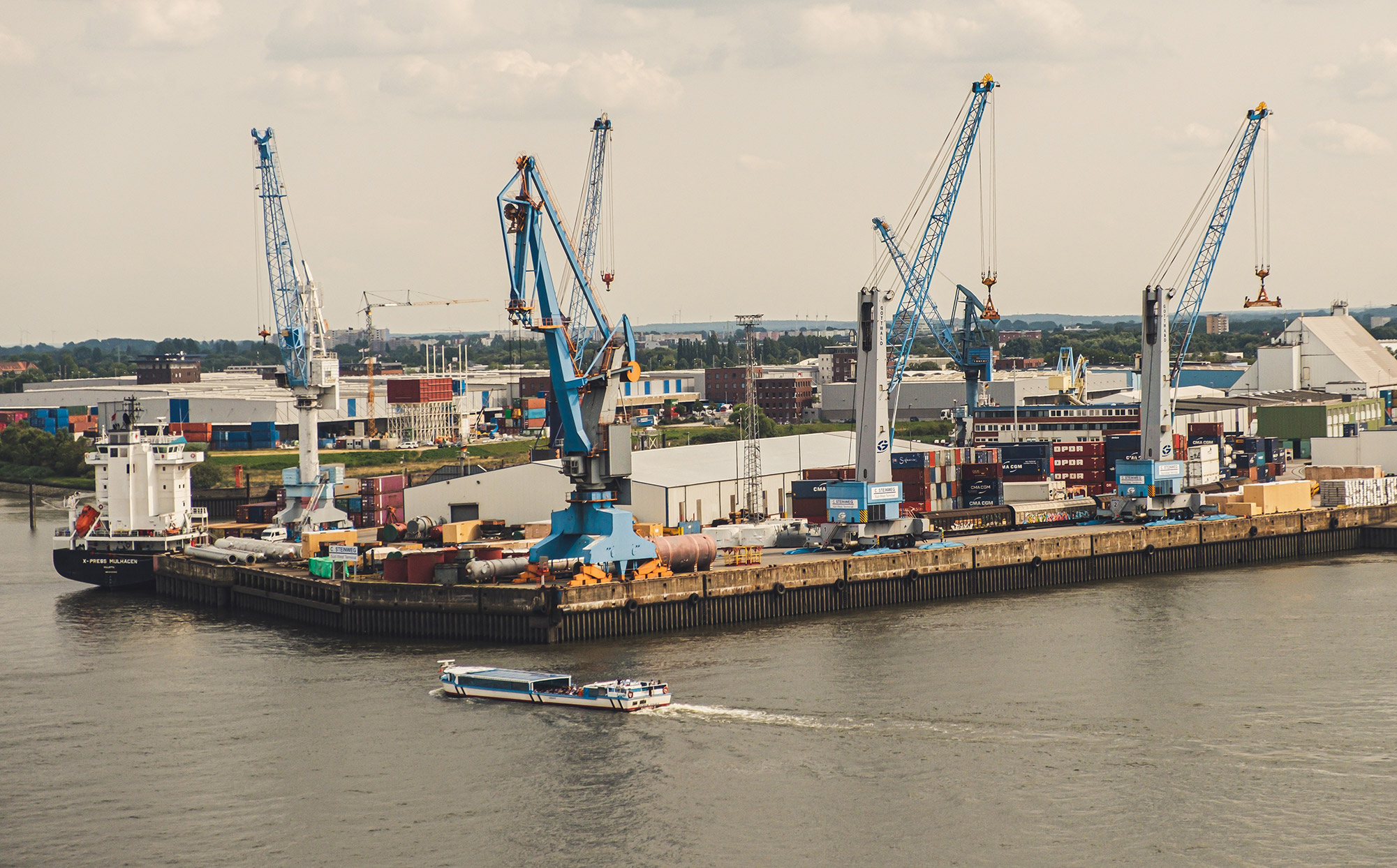
Is carbon neutrality and resource wisdom in a gated industrial area too narrow a perspective?
A resource-wise and carbon-neutral maritime industry network
reduce, reuse, recycle
The project developed an optimal operating model for flows of materials, resources and information in the Blue Industry Park and Turku Shipyard. The model can be used to achieve resource wisdom and carbon neutrality throughout the supply chain.
- 20–30% increase in value-adding operations.
- 3–7% reduction in material loss.
- 20% better production turnaround time through supply chain transparency and management.
- 5% lower material costs through centralised procurement.
This solution is right for you if
- you operate in the supply chain of Turku Shipyard;
- you operate in a manufacturing industry supply chain;
- you want to streamline your supply chain operations.
BASIC FACTS
- Location: Perno district, Turku. Next to Turku Shipyard.
- Industrial area life cycle: planning phase
- Organiser: Blue Industry Park Oy.
- Time span: 5–10 years from 2021 onwards.
- 600 companies in the supplier network.
- The maritime industry network in southwestern Finland employs 11,000 people.
- The turnover of the maritime industry network was EUR 3.3 billion in 2019.
The aim is to increase the efficiency of the maritime industry network
The concept identified how the operations of the maritime industry network could be streamlined, and an operating model was created for the planning and implementation of these improvements. The aim was to optimise the material, resource and information flows between the Blue Industry Park (BIP) and Turku Shipyard. The project assessed what kind of operating methods the companies in the maritime industry network should use in order to make the network’s operations as resource-wise and carbon-neutral as possible. Finally, it was determined what kind of control system would support resource-wise and carbon-neutral operations.
The logistics centre offers the best support to resource-wise and carbon-neutral operations
The concept determined which activities should be located in the BIP area in order to make the maritime industry network as efficient as possible and to support resource-wise activities. The key functionalities were production facilities and the logistics centre.
The need for production facilities varies: some operators require a small workshop while others need a larger production facility. The premises to be built must also be adaptable so that they can meet the changing demand. Pre-assembly and modularisation would also reduce the logistical burden in terms of traffic volumes and packaging materials. Traffic volumes are reduced when larger entities are transported and there are fewer deliveries of parts and components in the area.
Recycling reduces material waste
Recycling packaging waste and standardising transport packaging in the area would be very beneficial. If standardised methods were used for recyclable packaging materials, logistics operations would be clearer and the volume of packaging materials in the area would be reduced.
Building a centralised recycling centre in the BIP would serve companies in the area and help ensure that waste materials are recycled. The recycling centre would operate in the area between the BIP and the shipyard, which would be ideal for all parties.
With regard to the location of functionalities, traffic going into the shipyard must also be considered. The logistics centre should be located either beside or in the immediate vicinity of the production facilities in order to avoid any unnecessary traffic.
Information creates trust
Yhteistoiminnan ja resurssiviisauden edistämiseksi tarvitaan mitattua tietoa. Konseptiin liittyen määriteltiin viisi tärkeitä mittaria:
Measured data is required to promote collaboration and resource wisdom. Five important indicators were identified in relation to the concept:
- Security of supply of incoming materials
- DIFOT (Delivered In Full and On Time)
- Security of supply of site-specific material packages
- DIFOT (Delivered In Full and On Time)
- Progress of the site-specific plan
- Timing and accuracy of master production scheduling
- Timing and accuracy of detailed planning
- Implementation of the plan content
- Monitoring deviations
- Work package-specific monitoring
- Delivery line-specific monitoring
- Monitoring of transport volumes
- Monitoring of inbound logistics
- Monitoring of reverse logistics and material loss, surplus/waste
- 3R strategy (Reduce, Reuse, Recycle)
TAKE-HOME MESSAGES
- Material wisdom: centralised materials management can reduce material waste.
- Resource wisdom: minimising the amount of surplus material with more careful planning.
- Information wisdom: the information flow generated by the digital platform enables supply chain management and development.
“Stopping structural waste is the only way to save the planet.”
–Ari Viitanen, HPJ CarinaFour
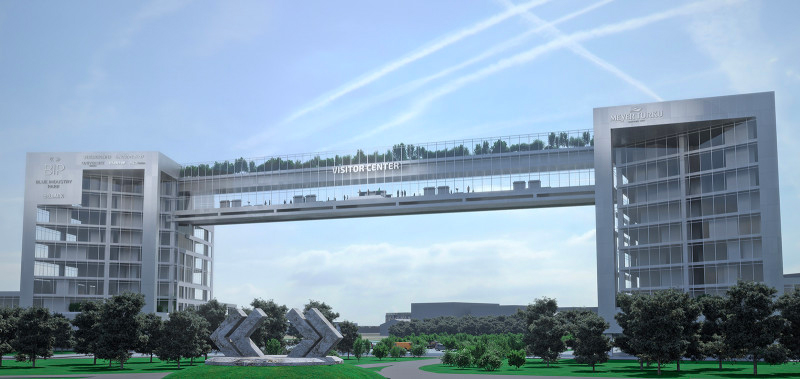
How to create a new resource-wise and carbon-neutral industrial area?

Blue Industry Park: the new resource-wise and carbon-neutral industrial area
hiilineutraali teollisuusalue
When building a carbon-neutral and resource-wise industrial area, it is necessary to take into account not only the planning but also the construction of the area and its day-to-day operations. The Blue Industry Park is an area that is gradually being built beside the Turku Shipyard, and it will be a functioning ecosystem of manufacturing industries and service operators. It takes the expertise and willing of all companies to achieve resource wisdom and carbon neutrality in the area.
- Blue Industry Park Oy. Established during the project to lead the construction of the area.
- Great transport links. Deep-water channel, E18, railway and distance to the airport 10 km.
- 55 hectares. Total area
This solution is right for you if
- you operate in the supply chain of Turku Shipyard;
- you operate in a manufacturing industry supply chain;
- you want to streamline your supply chain operations;
- you are planning a carbon-neutral and resource-wise industrial area;
- you are a contractor or developer in a carbon-neutral and resource-wise industrial area;
- you are a public operator, such as a planning officer, and you want to know how carbon neutrality and resource wisdom are implemented.
BASIC FACTS
- Location: Perno district, Turku. Next to Turku Shipyard.
- Industrial area life cycle: planning phase
- Organiser: Blue Industry Park Oy.
- Time span: 5–10 years from 2021 onwards.
- The maritime industry network in southwestern Finland employs 11,000 people.
- The value of Turku Shipyard’s order book in Q1/2021 is EUR 6.5 billion, cruise ship deliveries until 2026.
Towards a sustainable future
Blue Industry Park is a close-knit and diverse community of companies and research institutes, which are leading the change. There are no limits to its growth opportunities. The scalable spaces and shared resources provided in the area reduce the need for non-essential investments and enable business development in a sustainable and commercially viable manner. The community is responding to megatrends of production modularity and circular economy on a scope never seen before.
New technologies and cooperation are prerequisites for success
The concept guidelines do not provide ready-made solutions for the future, but they encourage all parties to share their expertise to achieve the shared goal. For the area to be successful, the best and most sustainable technologies and operating models available must be applied in every phase and solution.
The guidelines cover solutions for design and civil engineering, buildings and operations as well as transport.
Blue Industry Park’s ecosystem also includes service companies such as occupational health care, lunch restaurants and a visitor centre. Renewable energy sources are preferred, of course, and carbon neutrality is achieved by combining several solutions.
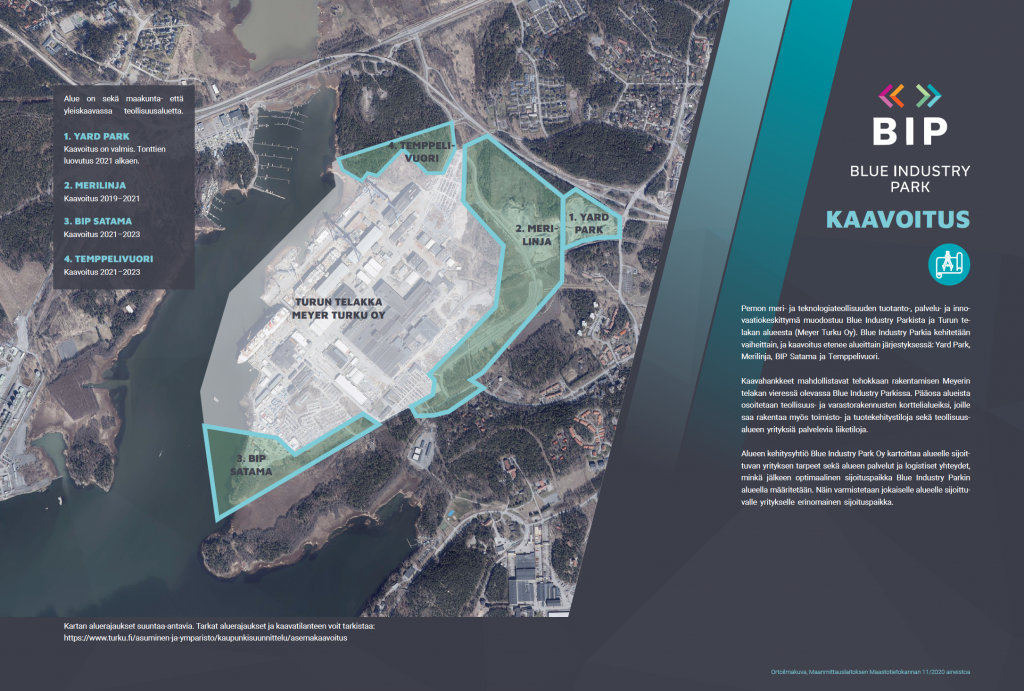
Research collaboration with universities
It is valuable for companies operating in the area that there are four institutes of higher education in Turku with research related to the maritime industry and maritime logistics. Blue Industry Park is a platform for productive cooperation in research projects and the supply of skilled labour both now and in the future.
The universities in Turku cover disciplines that are relevant to planning and building the area, such as energy technology, structural engineering, circular economy, economics and industrial management engineering.
TAKE-HOME MESSAGES
- The area’s location in relation to existing transport links and major customers is essential to minimise emissions from transport.
- When building the area, the use of land masses in the region and the area under construction must be optimised so that unnecessary transportation and costs can be avoided.
- Renewable energy production, transmission and storage solutions need to be considered at the planning phase.
- The flexibility and modularity of the facilities improve their occupancy rate and cost efficiency.
- Sharing machinery and equipment makes it easier to adopt new eco-friendly technologies and reduces the number of equipment needed in the area.
- There must be a leader with a clear role to create an area that runs on synergy and cooperation.
”Companies must assess and develop their practices: new ideas only come from doing things differently. We know that those who can realise their full growth potential, find the right partners and work in a carbon-neutral and resource-wise manner will be successful.”
– Tero Lahti, CEO, Blue Industry Park Oy.
Download

How can nature-based solutions be used to advance carbon neutrality and preparedness for climate change in industrial areas?

Nature-based solutions for industrial areas
urban planning, green coefficient, carbon sink, preparedness, biodiversity, green waste, circular economy
Industrial areas typically have a large surface area of roofs and paved areas, which accentuates the adverse effects of climate change, such as floods and heat waves. In the Blue Industry Park in Turku, the management of storm water and floods is seen as particularly important even though nature-based solutions for preparing for climate change also increase the number of carbon sinks, makes the environment more enjoyable and protects endangered species.
This concept is right for you if
- you are planning a carbon-neutral industrial area;
- you are looking for ways to prevent the adverse effects of climate change and/or biodiversity loss; or
- you are interested in circular economy solutions in green space management.
BASIC FACTS
- Location: Blue Industry Park, Turku
- Industrial area life cycle: planning stage, infrastructure construction stage
- Organisers: city of Turku and students in the Circular Economy 2.0 course at Turku University of Applied Sciences
Urban planning ensures competitiveness and preparedness for change
The key objectives of the Turku City Strategy are the well-being and activity of citizens and competitiveness and sustainable growth of businesses. Competitiveness is built on dynamic businesses and the fact that companies want to operate in the city. By offering companies a competitive and business-friendly operating environment, the city also attracts international talent and organisations. Support for company service production and innovation-promoting networks will also contribute to the development of circular economy and the creation of jobs.
The city’s operating environment is changing due to climate change, digital transformation and positive structural change. This means that urban planning must stay ahead of this change. The fight against climate change means that energy efficiency and resource wisdom must be taken into account in all planning and activities. It is also important to protect biodiversity, and the significance of this will only become clearer as the city adapts to future changes and tries to mitigate their impact. The city is committed to reducing the environmental load from nutrient runoffs that intensify eutrophication and emissions from ships and boats as well as improving its oil spill preparedness.
Carbon-neutral and resource-wise Turku improves operating environment for businesses
Turku is aiming for carbon neutrality by 2029 and resource wisdom by 2040. How well these ambitious targets are met depends partly on businesses. It is estimated that the city of Turku can achieve around half of the required emissions reductions by making changes to its practices, while the remaining reductions must come from businesses and residents.
When planning for an industrial area, the city can decide to create a business-friendly operating environment that enables carbon-neutral and resource-wise operations. The city aims to develop a functional urban structure and sustainable and seamless logistics and personal transportation while taking into consideration the internal solutions of the industrial area and the way the area is connected to the surrounding city through traffic, energy and services.
Energy use and production for heating, cooling and electricity accounts for around half of Turku’s emissions (in 2020). The city’s energy system reform will enable companies to use fossil-free district heating based on renewable sources. A frictionless licensing process for solar energy and the continuous development of smart energy solutions boost carbon-neutral energy production and circular economy.
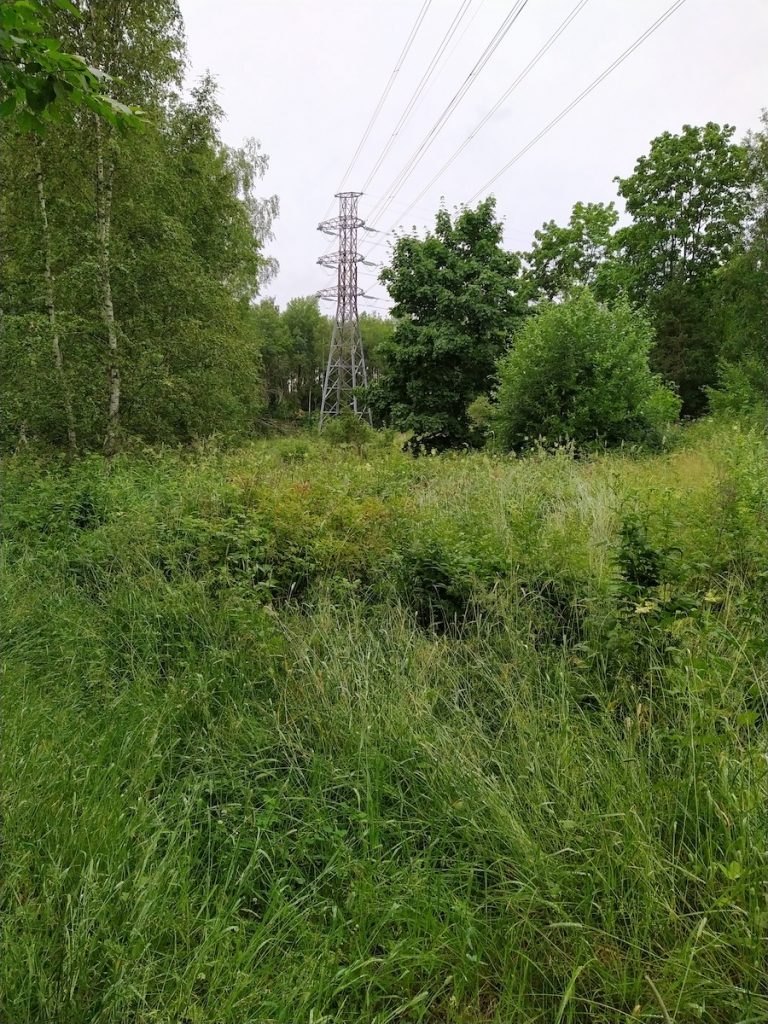
The protection of carbon sinks starts at the drawing board
All the work done at an industrial area’s founding stage, such as felling trees, blasting rocks and earthmoving, affects the area’s nutrient cycle, carbon balance and water economy. The nature inventory carried out at the planning stage will identify valuable nature types and habitats to be saved but most of the area’s carbon sinks and stocks will be cleared off. For the area’s carbon balance, this will mean a negative balance from the outset.
The planning stage is the most important stage when striving to create a carbon-neutral and resource-wise industrial area. Nature-based solutions, trees and green spaces are used to manage storm water and to minimise urban heat islands, for example. Implementing the principles of circular economy can bring savings in green space management. Some nature-based solutions do not require areas to be protected from construction altogether but the solutions can be implemented so that areas are efficiently used while retaining some of the particularly valuable elements of nature. High biodiversity and enjoyable surroundings also increase the value of an area in the eyes of its users and visitors alike.

TAKE-HOME MESSAGES
- The protection of carbon sinks must be ensured at the planning stage.
- “Green coefficient” is a useful tool for planners that can be used in the planning of nature-based solutions.
- Nature-based solutions and green space management can ensure high biodiversity even in densely built-up areas.
“Nature-based solutions for adapting to climate change can be developed and implemented even further (including in densely built-up areas).”
– The climate impact report for the Turku Master Plan 2029, CANEMURE project
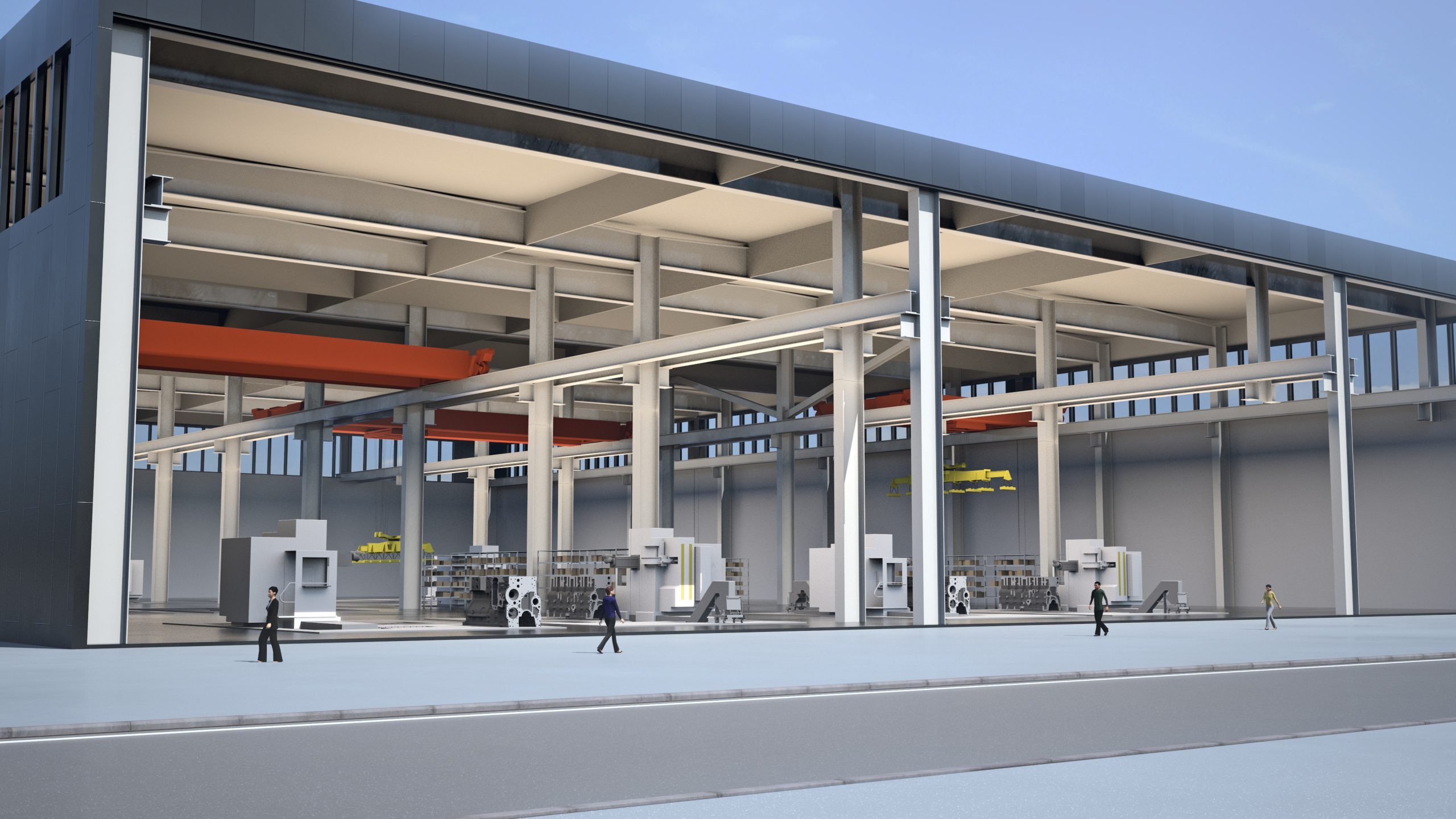
How can ambitious climate goals be achieved through collaboration between cities and businesses?

Businesses and cities work together to become carbon-neutral and resource-wise
carbon-neutral, trade and industry, SME, industrial area, climate projects, climate team, climate partners, climate commitment, SECAP, Blue Industry Park
Cities can support industrial areas, business networks and individual companies through various means and incentives to develop their activities to become carbon-neutral and resource-wise and contribute to building a carbon-neutral city. For companies, cooperation and networking can also offer new business opportunities, especially in operations related to resource wisdom and circular economy.
- Turku Shipyard, which employs 2,000 people, proves by way of example that carbon-neutral solutions matter on the scale of industrial areas.
- Four weeks of intensive training was a great way to introduce climate activities into companies and commit them to the city’s climate targets.
- Eight companies benefitted from the training, as it was customised to meet the needs of individual companies.
This solution is right for you if
- you are looking for ways to develop climate cooperation between the city and companies;
- you want to encourage the businesses in your industrial area to become carbon-neutral and resource-wise;
- you want to have access to a carbon-neutral and resource-wise training package. The package is suitable for instructors, research institutes, educational institutions, cities and entrepreneurial organisations that aim to provide companies with advice and training on carbon neutrality.
Basic facts
- The carbon-neutral and resource-wise business training package is an online course that can be implemented anywhere, anytime.
- Organisers: City of Turku, University of Turku and City of Helsinki.
- The training package contains a lot of material on carbon neutrality and resource wisdom as well as a section of materials on circular economy by Turku University of Applied Sciences.
- The course material has been piloted once, and this was used as the basis for a training package and instructions for organising a course.
- Length of the course: 1 month, four training sessions.
Companies play a major role in the achievement of climate targets in cities
Promoting carbon-neutral and resource-wise business operations on an industrial area scale can have a significant impact on the sectors that emit the most greenhouse gases. The city can achieve about half of the emission reductions required to meet the ambitious climate targets through its own activities. This concept presents ways in which cities can support industrial areas, networks and businesses to improve their operations.
A sustainable urban structure promotes carbon-neutral operations in companies
Emissions from the energy sector in Turku have decreased rapidly in recent years, while the relative share from other sectors has increased. Emissions from electricity and district heating will decrease further, while road transport will become the sector with the highest level of emissions. The coronavirus may affect traffic volumes and the popularity of sustainable modes of transport in the coming years.
The goal in designing a sustainable urban structure is an industrial area in which energy solutions are carbon-neutral or climate-positive and companies’ material logistics, staff and visitors move and operate in a low-carbon and resource-wise manner. Significant decisions are made at an early stage of planning, and many of them are linked to regional targets. Solutions that promote the principle of an emission-free construction site are also taken into account when building the area. It is important to offer guidance in the operational phase. For example, the terms of land transfer and strengthening of cooperation in the business network will commit companies to climate action.
Networks and information to support climate activities in companies
Networks built around urban climate targets (e.g. Climate partners, Turku Climate Team) are a natural context for supporting companies on their journey to carbon neutrality and resource wisdom. They are environments where companies can offer peer support to each other, learn and gain visibility for their climate actions. The networks’ activities can also be linked to ongoing projects, enabling the projects to better reach their target companies, while the companies receive up-to-date information and encouragement.
Demand for information and support has grown significantly, and projects concerning circular economy, resource wisdom and carbon neutrality have been launched to meet this demand. Since companies’ climate activities have an impact on emissions, the project results also improve the climate targets of the cities in which they operate. It is also considered important that synergies and communications are shared between various projects. An information sharing network, coordinated by the city, was set up for climate projects that focus on companies operating in the Turku area.
Intensive training courses boost climate efforts
An intensive course on carbon-neutral and resource-wise companies, Hiilineutraali ja resurssiviisas yritys, was organised to provide companies with information on carbon neutrality and how to communicate their sustainability-related activities. Companies in the Turku area were offered the opportunity to join the Turku Climate team, which they could also use in their communications. They could join the team by filling in a SECAP card, which describes the content and impact of a climate action and is published in the city’s climate action database.
Eight companies from different sectors attended the pilot course through the online platform and set out to make their operations carbon-neutral and resource-wise. As part of the course they were offered specific sessions that focused on an area for improvement chosen by each company. The training was based on circular economy materials by Turku University of Applied Sciences, and a lot of new material was produced for the Howspace platform. The companies provided a lot of feedback on the course, and it was modified on the basis of this feedback. Other operators offering training can use the course and the materials that were generated during the pilot course.
TAKE-HOME MESSAGES
- It is a challenge to offer the same course to companies from different backgrounds operating in different sectors as one set of materials does not work for all of them.
- Howspace is a great training platform, without which it would be difficult to arrange training or, at least, it would require more creativity.
- Companies that attend the courses must be offered constant guidance, so coordinating and facilitating require a lot of resources.
- It can be difficult to find anyone to bounce ideas off unless the companies are willing to pay for it.
- Companies that attend the course should be monitored and engaged in the city’s climate activities even after the training is over.
- Silent conversation, or communicating using messages, is an important part of online training, and there needs to be sufficient time for it during training sessions. It is necessary to make it easier for companies to become involved and they need to be provided with more information so that climate cooperation between cities and companies can develop.
How to organize the HNRY training for companies – Instructions
The Carbon-neutral and resource-wise business training
In January and February 2021, the HNRY project organized the Carbon-neutral and resource-wise business training for companies. The training was targeted for small and medium enterprises (SME) in the maritime and metal industries, as well as for logistics and port operator companies, but registration was still open to companies of all sizes and industries. The aim of the training pilot was to support SMEs on their way to carbon-neutral and resource-wise activities and to encourage them to participate in city’s climate work.
Participating companies were Arkea Oy, Flegma Oy, Finess Energy Oy, MuotoMyrsky Oy, Steveco Oy, Turku Kaupunkiliikenne Oy, Workenter and 3PLogistiikka Oy. The Southwestern Finland’s Joint Municipal Authority for Education and the Åbo Akademi University Foundation took part in training sessions giving valuable feedback for in further development of HNRY training. The training pilot received good feedback from companies.
The training was given in the form of online lectures and sparring sessions, including independent studies aiming to plan and advance the climate work within participating company. Trainers and some of the sparring partners were specialists in carbon neutrality and resource wisdom, communication and marketing. Many participants were sparred by their peer companies who are experienced in climate work.
Training comprised of four lectures common to all and three private sparring sessions. In the sparrings, the company was able to receive new information, motivation and peer support for development goals that were identified already in the registration questionnaire.
The training was arranged via Zoom web conferencing tool and the Howspace platform. Have a look at the HNRY training in Howspace.
The training material
The material is open for use for everyone and suitable for business training organized by cities, research institutes, educational institutions and entrepreneurial organizations, as well as for self-study. Also, the videos produced by the CarbonWise project as well as the Circular Economy Business training material produced by Turku University of Applied Sciences, are found from this page (marked as italics).
The Welcome section
Prior to the first training session, participants were instructed to familiarize themselves with the Howspace training platform. The objectives were introduced and instructions for using Howspace and Zoom were provided in this section.
The first training: Why corporate climate actions matter
- Welcome to the HNRY training (pdf)
- Lauri Larvus, Gaia Consulting: Sustainable business opportunities through climate work (video)
- Eero Yrjö-Koskinen, Central Chamber of Commerce: Presentation of the Climate Commitment
- A task: Company introduction – Write a short introductory text about the company you represent and the motivators for carbon neutrality and resource wisdom.
The second training session: Carbon footprint and sources of emission
- Maija Saijonmaa, Nordic Offset: Principles of Emission Calculation and Greenhouse Gas Compensation (video)
- Mari Saario, Gaia Consulting: Calculating the carbon footprint
- Company example: Valmet Automotive, Jaana Hänninen: How Valmet Automotive considers its carbon footprint in its strategy (video)
- Introductory videos of various counters and tools
- JAMIX carbon footprint counter
- One Click LCA Lifecycle Assessment Tool
- OpenCO2 counter
- Y-carbon
The third training course: Responsibility communication
- Kirsi Liira, Neste: How to communicate effectively about climate actions? (video)
- Maarit Jaakola, Turku University of Applied Sciences: Concepts of Carbon Wisdom (video)
- Successful responsibility communication for SME
- An eco-compass guide to environmental communication
- Homework: Prepare one slide and a five-minute speech to explain the most relevant matter you learned in the trainings and sparring sessions. Also present your company’s climate work development plan for future.
The fourth training session: What does the future hold?
- Ilmastoapu – Consultancy for companies
- Participating companies presenting their learnings and development plans
The circular economy material
This section consisted of materials produced in the Turku University of Applied Sciences’ Circular Economy in Business training.
The Closing session
This session included an evaluation and feedback form, information on the HNRY video series, and a preliminary invitation to the spring meeting “Climate coffee for companies”. The meeting included private discussion sessions for companies to assess the progress in their climate work.
More information about the training
Niina Ruuska, City of Turku, niina.ruuska@turku.fi, p. +358 40 358 9353
“Where can small operators find practical help for carbon accounting and offsetting? I’m sure that it would be possible to reduce emissions significantly simply by offering advice to companies and “holding their hands” at the start of the process.”
– Course participant
Download
Links
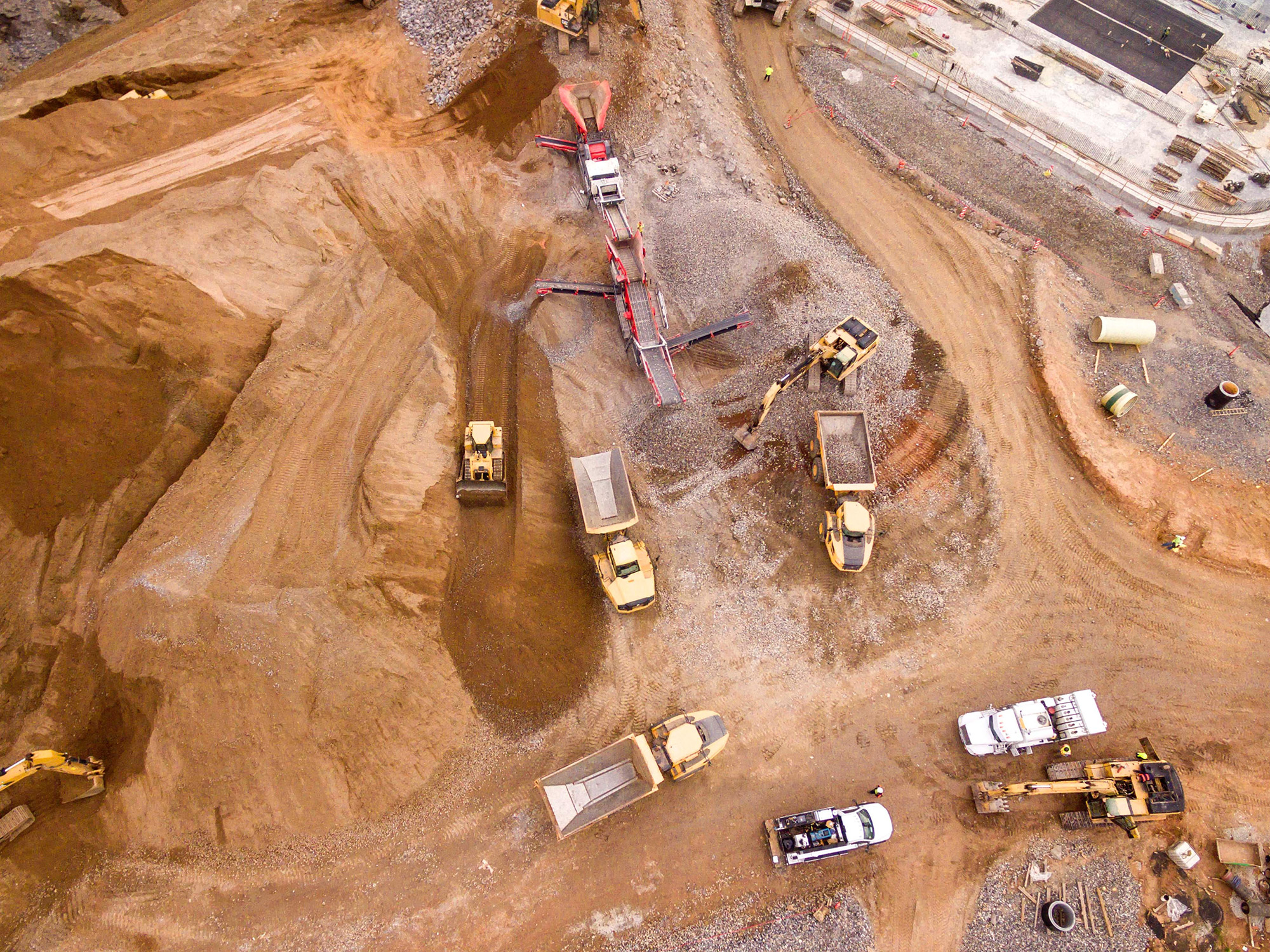
Is there any use for surplus clay from construction sites as landfills fill up?

Businesses and cities work together to become carbon-neutral and resource-wise
carbon-neutral, trade and industry, SME, industrial area, climate projects, climate team, climate partners, climate commitment, SECAP, Blue Industry Park
We studied the use of clay as a component in an aggregate product that could be used in land development while reducing the climate impact of construction. The use of clay as a production material could potentially reduce emissions and costs caused by the transportation of clay and production of virgin materials for construction.
- Supply and demand
The profitability of using clay as a raw material is primarily determined by the market potential of the product or products and the cost structure of the production plant. Surplus clay as a raw material is practically free, and directing the currently levied landfill gate fees differently could serve as an incentive for using clay as a raw material in production.
- Environmental permits
The surplus clay from construction sites is classified as waste if it is not assigned to be used for something else. This classification of clay as waste can be prevented by conducting relevant research and planning in advance, but soil could be used much more efficiently if clay that has already been dug up could also be reclassified.
- Cooperation
The key to the successful use of clay is to rethink established practices in “ecosystems” where operators in different sectors can collaborate to develop opportunities for business around circular economy.
This solution is right for you if
- you work with geotechnics or mass coordination;
- you are a developer in an area with a large number of clay pits (capital and coastal regions) and a fast growing city with many construction projects; or
- you plan business operations that use industrial side streams and waste heat.
BASIC FACTS
- The location of the industrial area. Construction site, landfill. Concept implemented by the city of Espoo and its Public Works Department and Environment Centre. Ramboll acts as consultant.
- Duration: from October 2020 onwards. The study on clay is ongoing as a collaborative development effort coordinated by the Espoo Public Works Department.
- The city of Espoo provides the framework for the new circular economy-based business and brings together expertise, market knowledge and different interest groups.
The majority of the soil brought to the Kulmakorpi landfill is clay
Transferring surplus clay from construction sites to landfills creates both costs and emissions. Within our project, Espoo has tried to find a solution to the problem by looking into ways to process surplus clay produced across the capital region into a lightweight expanded clay aggregate. One of the central themes of circular economy is resource efficiency, which means the most efficient possible use and reuse of exiting materials. By using surplus clay, we can prevent the acquisition of virgin materials and the resulting climate and environmental impacts.
Our study on clay included basic research, test-baking clay from Espoo, a workshop and final report
In the study, the potential of clay as a raw material was examined while taking into account both production factors and market potential. The study examined, for example, the characteristics of clay with regard to thermal processing, potential forms of production and energy sources, applications for use and market potential.
Preliminary research consisted of expert interviews and discussions. The actual study included the examination of data and a workshop. During the workshop, the results from the preliminary research were further discussed, the Åbo Akademi University presented the results and conclusions of their thermal treatment testing, interest in the topic among operators in the industry was reviewed and knowledge and experience in the use of surplus clay was gathered from interest groups.
The thermal processing methods of clay are based on drying and burning. The treatment temperature and the physical and chemical properties of clay determine the properties of the final product. The expansion of clay is essential in the production of products such as lightweight expanded clay aggregate. The properties indicating expansion potential were found to include clay content, water content, dry unit weight and the quantity of organic material. Preliminary research on clay plays an important role in identifying the clay types suitable for production and ensuring smooth further processing. Preliminary research should be included in construction planning as early in the process as possible.
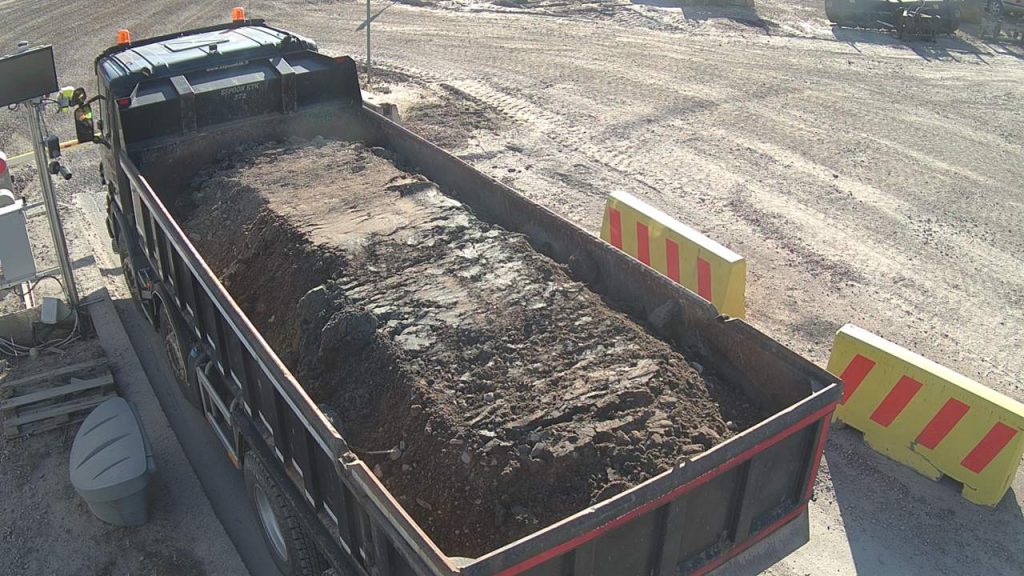
The market potential of a product is based on demand, i.e. the application potential and price in relation to similar products
Recycled lightweight expanded clay aggregate production can be divided into three “production lines”: 1) recycled lightweight expanded clay aggregate which does not meet the requirements of traditional lightweight expanded clay aggregates; 2) clay aggregate from crushed “burnt” clay; and 3) embankment clay, which is dried clay. Clay aggregate and embankment clay are terms used for the purpose of the study and they do not correspond with any official classification or existing products. This type of product would be used like stone aggregate and is in competition with virgin stone aggregate and some recycled materials that are typically low-cost materials. This means that any new product must either have properties that the competing materials do not have or must be cheaper.
The use of surplus clay, or any other recycled materials, requires communication across different sectors and extensive prior research
Our study on clay provides a preliminary overview of the potential of surplus clay as a raw material across the capital region. Research on the suitability of local clay types for thermal treatment provides basic information on the properties of these clays but a more detailed analysis of production or production potential requires further examination and studies. The use of clay in several different production lines or transportation of suitable clay raw material to an aggregate plant require further investigation. The discussions sparked by our study are the primary medium for exploring alternatives, altering practices identified as preventing the use of surplus clay and integrating resource sustainability as part of the construction industry.
With the current cost structure, producing recycled lightweight expanded clay aggregate or a similar product is more expensive than acquiring virgin stone aggregate. The cost structure of an aggregate product depends on how the costs of other uses of surplus clay are taken into account and how much saving natural materials and recycling are valued. Carbon dioxide emissions from materials may become a significant factor in procurement alongside cost and technical suitability. However, before the current conditions change, public operators play a key role in enabling the use of clay and providing potential sites for applications.

TAKE-HOME MESSAGES
- In order to launch the production of clay aggregate, we need a collaborative ecosystem in which operators in different sectors develop business opportunities around circular economy together.
- The profitability of using clay as a raw material in production is primarily determined by the market potential of the product or products and the cost structure of the production plant.
- In future procurements, the carbon footprint of products may become the decisive factor alongside cost.
- In addition to permits, such as environmental permits, the classification of clay as waste is a significant factor affecting the planning of production.
“When procurement decisions are based on CO2 emissions, the production of recycled aggregates can become profitable. For as long as money is the priority, public operators have a key role in enabling the use of clay.”
— Workshop participant
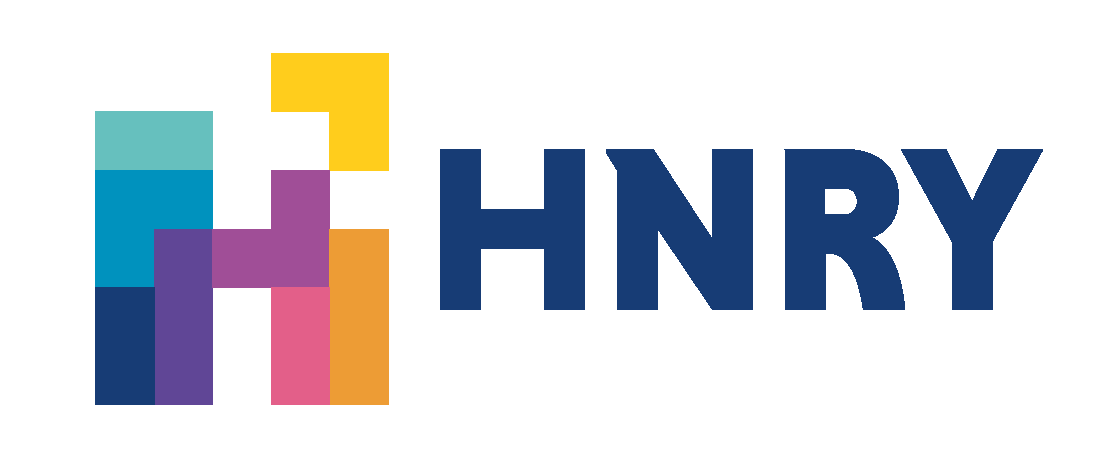

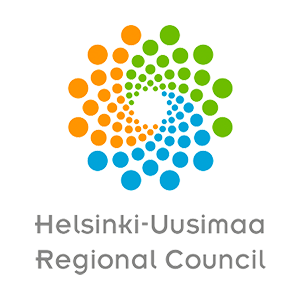
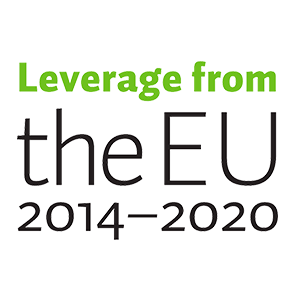
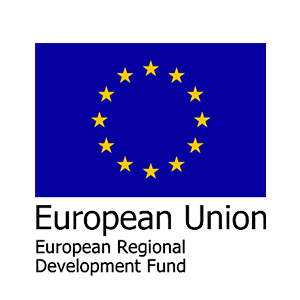
 VTT kehittää Helsingin, Espoon, Vantaan ja Turun yritysalueille vähähiilisiä toimintatapoja
VTT kehittää Helsingin, Espoon, Vantaan ja Turun yritysalueille vähähiilisiä toimintatapoja